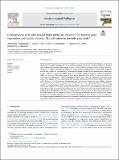Consequences of in vitro benzyl butyl phthalate exposure for blubber gene expression and insulin-induced Akt activation in juvenile grey seals
Abstract
Plastic and plasticiser pollution of marine environments is a growing concern. Although phthalates, one group of plasticisers, are rapidly metabolised by mammals, they are found ubiquitously in humans and have been linked with metabolic disorders and altered adipose function. Phthalates may also present a threat to marine mammals, which need to rapidly accumulate and mobilise their large fat depots. High molecular weight (HMW) phthalates may be most problematic because they can accumulate in adipose. We used blubber explants from juvenile grey seals to examine the effects of overnight exposure to the HMW, adipogenic phthalate, benzyl butyl phthalate (BBzP) on expression of key adipose-specific genes and on phosphorylation of Akt in response to insulin. We found substantial differences in transcript abundance of Pparγ, Insig2, Fasn, Scd, Adipoq and Lep between moult stages, when animals were also experiencing differing mass changes, and between tissue depths, which likely reflect differences in blubber function. Akt abundance was higher in inner compared to outer blubber, consistent with greater metabolic activity in adipose closer to muscle than skin, and its phosphorylation was stimulated by insulin. Transcript abundance of Pparγ and Fasn (and Adipoq in some animals) were increased by short term (30 min) insulin exposure. In addition, overnight in vitro BBzP exposure altered insulin-induced changes in Pparγ (and Adipoq in some animals) transcript abundance, in a tissue depth and moult stage-specific manner. Basal or insulin-induced Akt phosphorylation was not changed. BBzP thus acted rapidly on the transcript abundance of key adipose genes in an Akt-independent manner. Our data suggest phthalate exposure could alter seal blubber development or function, although the whole animal consequences of these changes are not yet understood. Knowledge of typical phthalate exposures and toxicokinetics would help to contextualise these findings in terms of phthalate-induced metabolic disruption risk and consequences for marine mammal health.
Citation
Tranganida , A , Hall , A J , Armstrong , H C , Moss , S E W & Bennett , K A 2023 , ' Consequences of in vitro benzyl butyl phthalate exposure for blubber gene expression and insulin-induced Akt activation in juvenile grey seals ' , Environmental Pollution , vol. 316 , no. 2 , 120688 . https://doi.org/10.1016/j.envpol.2022.120688
Publication
Environmental Pollution
Status
Peer reviewed
ISSN
0269-7491Type
Journal article
Description
Funding information: KAB, SEWM and HCA were funded by NERC grant NE/M013723/1 and AJH was funded by NE/M01357X/1 for this project. We received additional funding to AJH and KAB through the University of St Andrews from a private donor via the March Initiative and to KAB and AT at Abertay University from the Scottish Funding Council.Collections
Items in the St Andrews Research Repository are protected by copyright, with all rights reserved, unless otherwise indicated.

